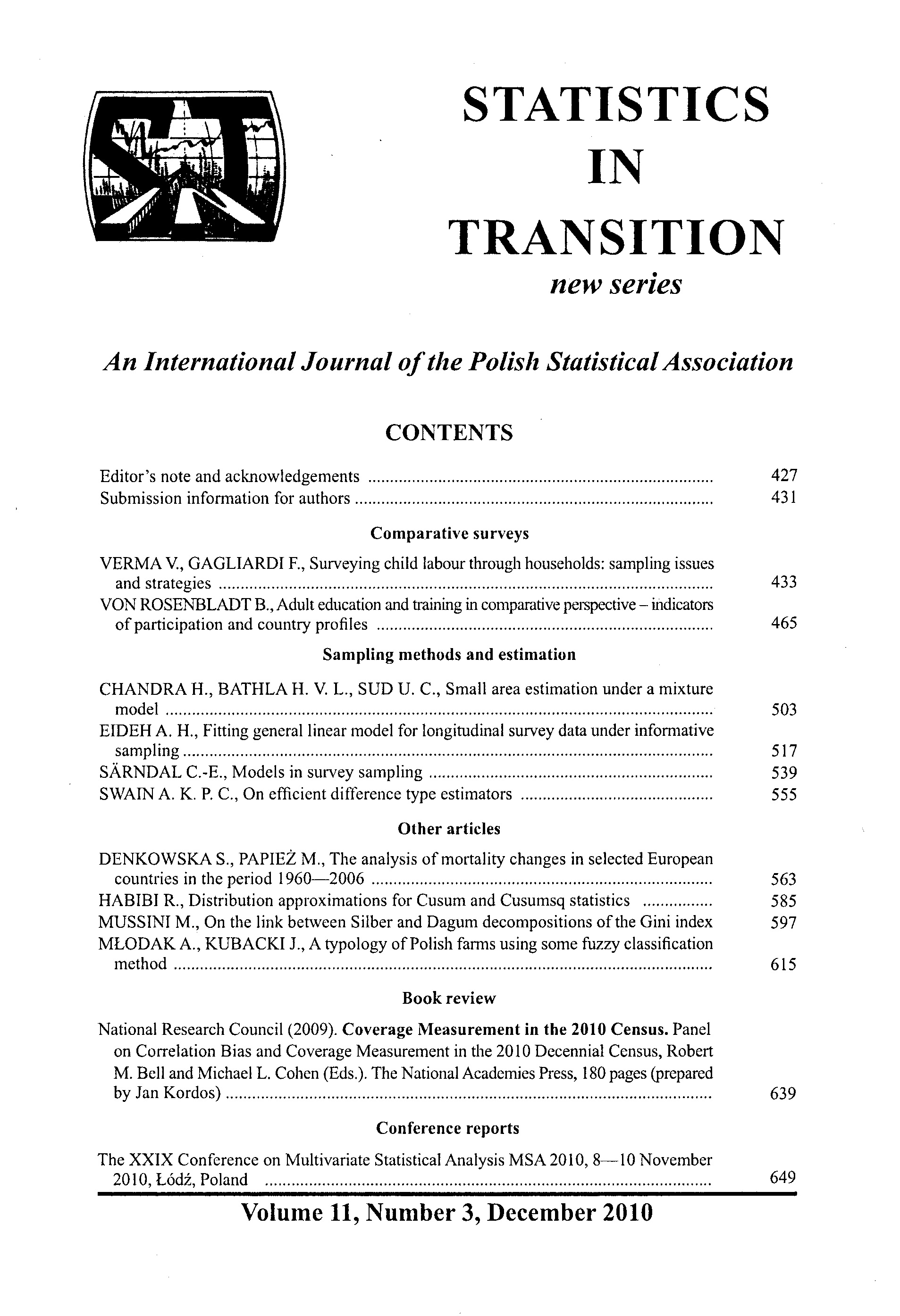ARTICLE
ABSTRACT
In this paper, we combine two alternative procedures for decomposing the Gini index: the Silber matrix approach and the Dagum technique based on Gini mean difference. This combined decomposition can be used for overlapping as well as no overlapping population subgroups. The presented decomposition procedure derives the within-group, the between-group, and the overlapping inequalities by exploiting all of the information on income distribution contained in one matrix accounting for pair wise disparities between per capita income shares. Moreover, this matrix approach can serve the scope of counting the frequency of overlapping, providing new insights for a more complete analysis of overlapping. The suggested methodology is applied to survey data on Italian employee incomes in 2000 and 2008.
KEYWORDS
Inequality measure; Gini decomposition; overlapping.
REFERENCES
ABADIR, K. M., MAGNUS, J. R., (2005), Matrix Algebra. Cambridge University Press, New York.
BANCA D’ITALIA, (2010), Survey on Households Income and Wealth. Supplements to the Statistical Bulletin - sample survey in 2008, sample survey in 2000. Available at http://www.bancaditalia.it/statistiche/indcamp/bilfait/boll_stat;internal&action=_setlanguage.action?LANGUAGE=en
BERREBI, Z. M., SILBER J., (1987), Regional Differences and the components of Growth and Inequality Change. Economics Letters, 25, 295-298.
BHATTACHARYA, N., MAHALANOBIS, B., (1967), Regional disparity in household consumption in India. American Statistical Association Journal, March, 143-162.
CALO, D. G., (2006), On a Transvariation Based Measure of Group Separability. Journal of Classification, 23, 143-167.
COSTA, M., (2008), Gini Index Decomposition for the Case of Two Subgroups. Communications in Statistics - Simulation and Computation, 37(4), 631-644.
DAGUM, C., (1987), Measuring the Economic Affluence between Populations of Income Receivers. Journal of Business & Economic Statistics, 5(1), 5-12.
DAGUM, C., (1997), A new approach to the decomposition of Gini income inequality ratio. Empirical Economics, 22, 515-531.
EBERT, U., (2010), The decomposition of inequality reconsidered: Weakly decomposable measures. Mathematical Social Sciences, 60, 94-103.
FALIVA, M., (1996), Hadamard matrix product, graph and system theories: motivations and role in Econometrics. In: Camiz, S., Stefani, S. (eds.) Matrices and Graphs, Theory and Applications to Economics, pp 152-175. World Scientific, London.
FRICK, J., GOEBEL, J., SCHECHTMAN, E., WAGNER, G., YITZHAKI, S., (2006), Using Analysis of Gini (ANOGI) for Detecting Whether Two Subsamples Represent the Same Universe: The German Socio-Economic Panel Study (SOEP) Experience. Sociological Methods & Research, 34, 427-468.
GINI, C., (1912), Variabilita e Mutabilita. Bologna: Tipografia Paolo Cuppini.
GIORGI, G. M., (1999), Income Inequality Measurement: the statistical approach. In: Silber, J. (eds.) Handbook on Income Inequality Measurement, pp 245-267. Kluwer, Boston.
LIAO, T. F., (2008), The Gini unbound: analyzing class inequality with model-based clustering. In: Betti, G., Lemmi, A. (eds.) Advances on income inequality and concentration measures, pp 201-221. Routledge, New York.
MONTI, M. G., (2008), A note on the residual term R in the decomposition of the Gini Index. Argumenta Oeconomica, 20, 107-138.
MONTI, M. G., SANTORO, A., (2009), A note on between-groups inequality with an application to genders. Working Paper Series Econpubblica CRPS, n. 135 October available at http://papers.ssrn.com/sol3/papers.cfm?abstract_id=1338054
MOOKHERJEE, D., SHORROCKS, A.F., (1982), A decomposition analysis of the trend in UK income inequality. Economic Journal, 92, 886-902.
MUSSARD, S., (2004), The Bidimensional Decomposition of the Gini Ratio. A case Study: Italy. Applied Economics Letters, 11(8), 503-505.
PYATT, G., (1976), On the interpretation and disaggregation of Gini Coefficient. The Economic Journal, 86, 243-255.
SORENSEN, J., (1990), Perception of women?s opportunity in five industrialized nations. European Sociological Review, 6(2), 151-164.
SHORROCKS, A.F., (1984), Inequality decomposition by population subgroups. Econometrica, 52, 1369-1385.
SILBER, J., (1989), Factor Components, Population Subgroups and the Computation of the Gini Index of Inequality. Review of Economics and Statistics, 71, 107-115.
VERNIZZI, A., (2009), Applying the Hadamard product to decompose Gini, concentration, redistribution and re-ranking indexes. Statistics in Transition, 10(3), 505-525.
VERNIZZI, A., MONTI, M.G., MUSSINI, M., (2010), A Gini and Concentration Index Decomposition with an Application to the APK Reranking Measure. DEAS Working Paper n. 2010-10, Available at http://www.economia.unimi.it/uploads/wp/DEAS-2010_10wp.pdf
YITZHAKI, S., LERMAN, R., (1991), Income stratification and income inequality. Review of Income and Wealth, 37(3), 313-329.
YITZHAKI, S., (1994), Economic distance and overlapping distributions. Journal of Econometrics, 61, 147-159.
